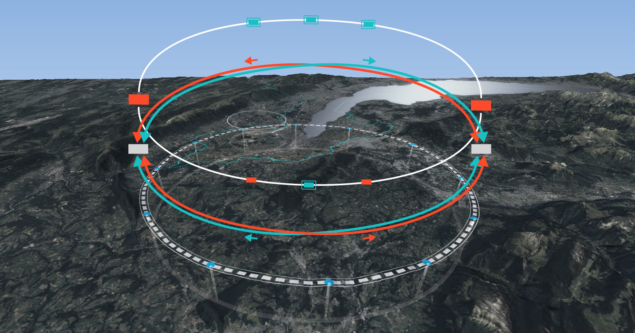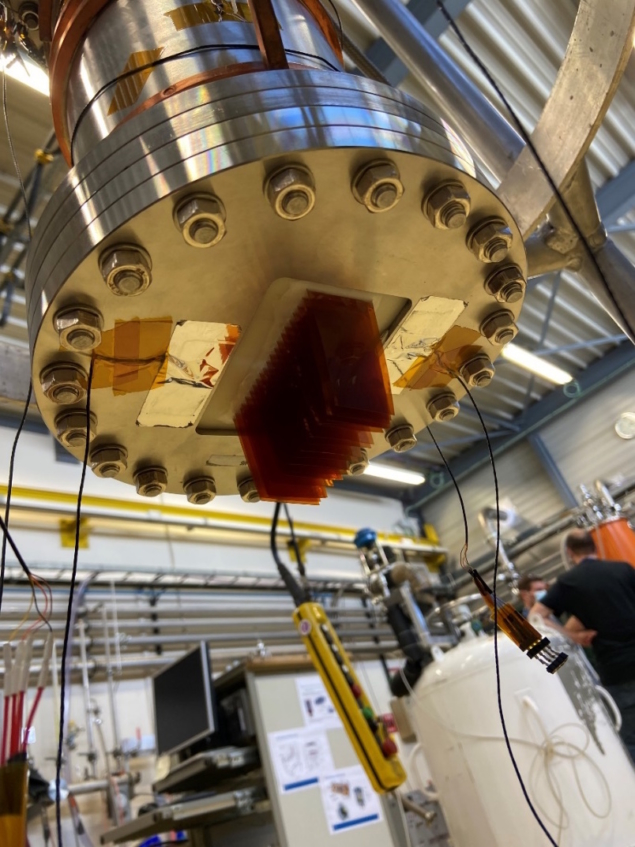
Ten years after the discovery of a Standard Model-like Higgs boson at the LHC, particle physicists face profound questions lying at the intersection of particle physics, cosmology and astrophysics. A visionary new research infrastructure at CERN, the proposed Future Circular Collider (FCC), would create opportunities to either answer them or refine our present understanding. The latest activities towards the ambitious FCC physics programme were the focus of the 5th FCC Physics Workshop, co-organised with the University of Liverpool as an online event from 7 to 11 February. It was the largest such workshop to date, with more than 650 registrants, and welcomed a wide community geographically and thematically, including members of other “Higgs factory” and future projects.
The overall FCC programme – comprising an electron-positron Higgs and electroweak factory (FCC-ee) as a first stage followed by a high-energy proton-proton collider (FCC-hh) – combines the two key strategies of high-energy physics. FCC-ee offers a unique set of precision measurements to be confronted with testable predictions and opens the possibility for exploration at the intensity frontier, while FCC-hh would enable further precision and the continuation of open exploration at the energy frontier. The February workshop saw advances in our understanding of the physics potential of FCC-ee, and discussions of the possibilities provided at FCC-hh and at a possible FCC-eh facility.
The overall FCC programme combines the two key strategies of high-energy physics: precision measurements at the intensity frontier and the open exploration at the energy frontier
The proposed R&D efforts for the FCC align with the requests of the 2020 update of the European strategy for particle physics and the recently published accelerator and detector R&D roadmaps established by the Laboratory Directors Group and ECFA. Key activities of the FCC feasibility study, including the development of a regional implementation scenario in collaboration with the CERN host states, were presented.
Over the past several months, a new baseline scenario for a 91 km-circumference layout has been established, balancing the optimisation of the machine performance, physics output and territorial constraints. In addition, work is ongoing to develop a sustainable operational model for FCC taking into account human and financial resources and striving to minimise its environmental impact. Ongoing testing and prototyping work on key FCC-ee technologies will demonstrate the technical feasibility of this machine, while parallel R&D developments on high-field magnets pave the way to FCC-hh.
Physics programme
A central element of the overall FCC physics programme is the precise study of the Higgs sector. FCC-ee would provide model-independent measurements of the Higgs width and its coupling to Standard Model particles, in many cases with sub-percent precision and qualitatively different to the measurements possible at the LHC and HL-LHC. The FCC-hh stage has unique capabilities for measuring the Higgs-boson self-interactions, profiting from previous measurements at FCC-ee. The full FCC programme thus allows the reconstruction of the Higgs potential, which could give unique insights into some of the most fundamental puzzles in modern cosmology, including the breaking of electroweak symmetry and the evolution of the universe in the first picoseconds after the Big Bang.
Presentations and discussions throughout the week showed the impressive breadth of the FCC programme, extending far beyond the Higgs factory alone. The large integrated luminosity to be accumulated by FCC-ee at the Z-pole enables high-precision electroweak measurements and an ambitious flavour-physics programme. While the latter is still in the early phase of development, it is clear that the number of B mesons and tau-lepton pairs produced at FCC-ee significantly surpasses those at Belle II, making FCC-ee the flavour factory of the 2040s. Ongoing studies are also revealing its potential for studying interactions and decays of heavy-flavour hadrons and tau leptons, which may provide access to new phenomena including lepton-flavour universality-violating processes. Similarly, the capabilities of FCC-ee to study beyond-the-Standard Model signatures such as heavy neutral leptons have come into further focus. Interleaved presentations on FCC-ee, FCC-hh and FCC-eh physics also further intensified the connections between the lepton- and hadron-collider communities.
The impressive potential of the full FCC programme is also inspiring theoretical work. This ranges from overarching studies on our understanding of naturalness, to concrete strategies to improve the precision of calculations to match the precision of the experimental programme.
The physics thrusts of the FCC-ee programme inform an evaluation of the run plan, which will be influenced by technical considerations on the accelerator side as well as by physics needs and the overall attractiveness and timeliness of the different energy stages (ranging from the Z pole at 91 GeV to the tt threshold at 365 GeV). In particular, the possibility for a direct measurement of the electron Yukawa coupling by extensive operation at the Higgs pole (125 GeV) raises unrivaled challenges, which will be further explored within the FCC feasibility study. The main challenge here is to reduce the spread in the centre-of-mass energy by a factor of around ten while maintaining the high luminosity, requiring a monochromatisation scheme long theorised but never applied in practice.

Detectors status and plan
Designing detectors to meet the physics requirements of FCC-ee physics calls for a strong R&D programme. Concrete detector concepts for FCC-ee were discussed, helping to establish a coherent set of requirements to fully benefit from the statistics and the broad variety of physics channels available.
The primary experimental challenge at FCC-ee is how to deal with the extremely high instantaneous luminosities. Conditions are the most demanding at the Z pole, with the luminosity surpassing 1036 cm-2s-1 and the rate of physics events exceeding 100 kHz. Since collisions are continuous, it is not possible to employ “power pulsing” of the front-end electronics as has been developed for detector concepts at linear colliders. Instead, there is a focus on the development of fast, low-power detector components and electronics, and on efficient and lightweight solutions for powering and cooling. With the enormous data samples expected at FCC-ee, statistical uncertainties will in general be tiny (about a factor of 500 smaller than at LEP). The experimental challenge will be to minimise systematic effects towards the same level.
The mind-boggling integrated luminosities delivered by FCC-ee would allow Standard Model particles – in particular the W, Z and Higgs bosons and the top quark, but also the b and c quarks and the tau lepton – to be studied with unprecedented precision. The expected number of Z bosons produced (5×1012) is more than five orders of magnitude larger than the number collected at LEP, and more than three orders of magnitude larger than that envisioned at a linear collider. The high-precision measurements and the observation of rare processes made possible by these large data samples will open opportunities for new-physics discoveries, including the direct observation of very weakly-coupled particles such as heavy-neutral leptons, which are promising candidates to explain the baryon asymmetry of the universe.
With overlapping requirements, designs for FCC-ee can follow the example of detectors proposed for linear colliders.
The detectors that will be located at two (possibly four) FCC-ee interaction points must be designed to fully profit from the extraordinary statistics. Detector concepts under study feature: a 2 T solenoidal magnetic field (limited in strength to avoid blow-up of the low-emittance beams crossing at 30 mrad); a small-pitch, thin-layers vertex detector providing an excellent impact-parameter resolution for lifetime measurements; a highly transparent tracking system providing a superior momentum resolution; a finely segmented calorimeter system with excellent energy resolution for electrons and photons, isolated hadrons and jets; and a muon system. To fully exploit the heavy-flavour possibilities, at least one of the detector systems will need efficient particle-identification capabilities allowing π/K separation over a wide momentum range, for which there are ongoing R&D efforts on compact, light RICH detectors.
With overlapping requirements, designs for FCC-ee can follow the example of detectors proposed for linear colliders. The CLIC-inspired CLD concept – featuring a silicon-pixel vertex detector and a silicon tracker followed by a 3D-imaging, highly granular calorimeter system (a silicon-tungsten ECAL and a scintillator-steel HCAL) surrounded by a superconducting solenoid and muon chambers interleaved with a steel return yoke – is being adapted to the FCC-ee experimental environment. Further engineering effort is needed to make it compatible with the continuous-beam operation at FCC-ee. Detector optimisation studies are being facilitated by the robust existing software framework which has been recently integrated into the FCC study.

The IDEA (International Detector for Electron-positron Accelerator) concept, specifically developed for a circular electron-positron collider, brings in alternative technological solutions. It includes a five-layer vertex detector surrounded by a drift chamber, enclosed in a single-layer silicon “wrapper”. The distinctive element of the He-based drift chamber is its high transparency. Indeed, the material budget of the full tracking system, including the vertex detector and the wrapper, amounts to only about 5% (10%) of a radiation length in the barrel (forward) direction. The drift chamber promises superior particle-identification capabilities via the use of a cluster-counting technique that is currently under test-beam study. In the baseline design, a thin low-mass solenoid is placed inside a monolithic, 2 m-deep, dual-readout fibre calorimeter. An alternative (more expensive) design also features a finely segmented crystal ECAL placed immediately inside the solenoid, providing an excellent energy resolution for electrons and photons.

Recently, work has started on a third FCC-ee detector concept comprising: a silicon vertex detector; a light tracker (drift chamber or full-silicon device); a thin, low-mass solenoid; a highly-granular noble liquid-based ECAL; a scintillator-iron HCAL; and a muon system. The current baseline ECAL design is based on lead/steel absorbers and active liquid-argon, but a more compact option based on tungsten and liquid-krypton is an interesting option. The concept design is currently being implemented inside the FCC software framework.
All detector concepts are under evolution and there is ample room for further innovative concepts and ideas.
Closing remarks
Circular colliders reach higher luminosities than linear machines because the same particle bunches are used over many turns, while detectors can be installed at several interaction points. The FCC-ee programme greatly benefits from the possibility of having four interaction points to allow the collection of more data, systematic robustness and better physics coverage — especially for very rare processes that could offer hints as to where new physics could lie. In addition, the same tunnel can be used for an energy-frontier hadron collider at a later stage.
The FCC feasibility study will be submitted by 2025, informing the next update of the European strategy for particle physics. Such a machine could start operation at CERN within a few years after the full exploitation of the HL-LHC in around 2040. CERN, together with its international partners, therefore has the opportunity to lead the way for a post-LHC research infrastructure that will provide a multi-decade research programme exploring some of the most fundamental questions in physics. The geographical distribution of participants in the 5th FCC physics workshop testifies to the global attractiveness of the project. In addition, the ongoing physics and engineering efforts, the cooperation with the host states, the support from the European physics community and the global cooperation to tackle the open challenges of this endeavour, are reassuring for the next steps of the FCC feasibility study.





